In Maine there comes a day in August when the weather turns. One day the temperature tops out at around eighty with ninety percent humidity. You sit in a pool of sweat. Then a rainstorm or a bout of wind blows through overnight and the next day the temperature has dropped ten degrees and the air is dry as a bone. You ponder wearing full-length pants for the first time since June.
Autumn is on its way.
As we turn into this new season, here’s a new batch of Finish Line quilts. These talented women each followed a different path to fabric collage but have arrived here together for your enjoyment and inspiration.
Accompanying their images are brief explanations of the origins of their quilts. For example, Lynn Koelsch describes the challenge of finding appropriate fabrics for her realistic rhino, above. Each fabric collage quilt is unique so each one has unique challenges—challenges that even with all my experience I can’t always foresee—making the stories of their solutions valuable learning tools.
Maybe you’ll find the information you need to help you break through a block and suddenly, like the change of seasons, you’ll be on your way.
If you too have a finished fabric collage quilt you’d like to submit, please use the link below.
Submit Quilt for "Finish Line"
Faith McLeod
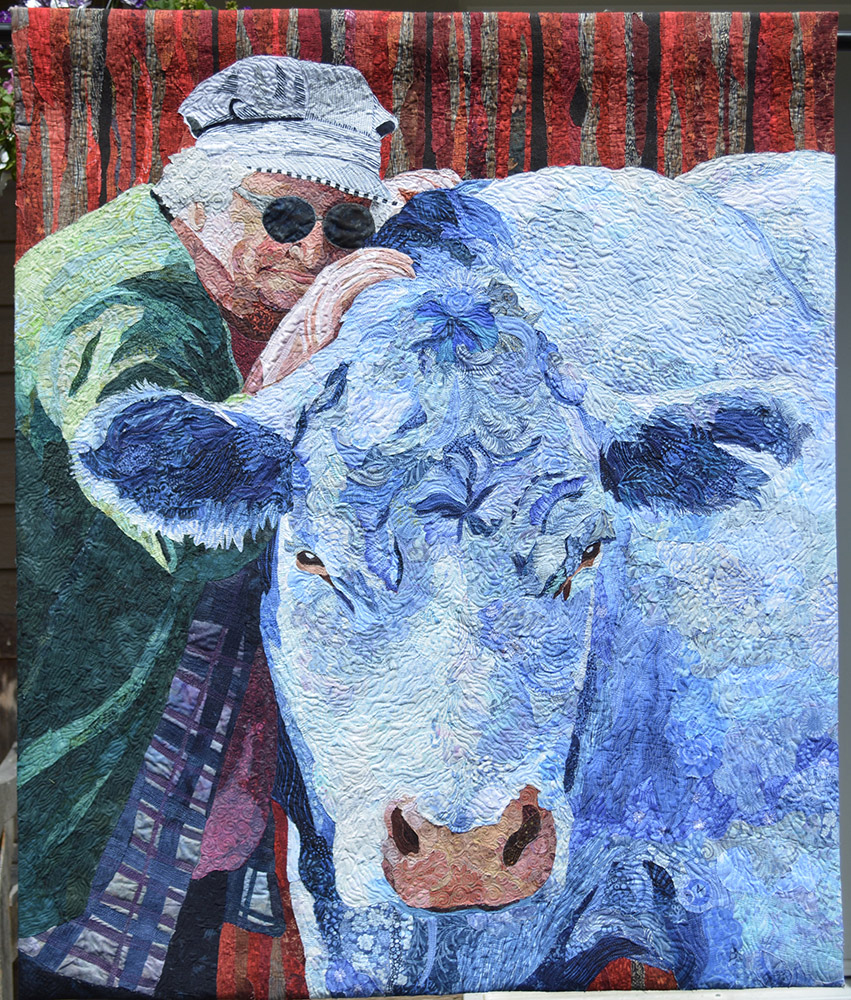
I remember the class where Faith started this quilt in June of 2019. There she is in the photo below. The artistic ability she demonstrated during that class made it clear that she would finish this ambitious quilt. As it turned out, I watched (and commented on) the development of the quilt over the rest of the year in an online Patreon members group. I look at this quilt and feel the love between these two, the love Faith has for them, and love is what she put into the quilt. Faith told the story of Bessie (the human friend) and Annie (the bovine friend) to the class and we fell in love with the pair as well. Be sure to read Faith’s story of Bessie and Annie below—and just try not to cry.
From Faith:
I started this quilt almost exactly a year ago when I traveled to Kalispell, Montana to take a class with Susan at the Quilt Gallery. It was my first collage, and I can remember how nervous I was to place the first few pieces on that huge piece of muslin. But with Susan’s gentle guidance I managed to get a good start. My poor husband suffered a lot when I came home, because my dining room was turned into a studio, and bits of fabric were tracked throughout the house for months!
BESSIE AND ANNIE
Faith passed along the story of Florence “Bessie” Spies and her best friend Annie the cow as told by Bessie’s daughter, Diane. Bessie hand-raised the orphan calf, Annie, after its mother died during the birth. Bessie installed the calf in the kitchen to keep an eye on her, moving her out and into the orchard pasture once she was weaned. Annie had developed a strong attachment to Bessie, her mum, however, and would come to the fence for hugs and scratches whenever Bessie called.
“Annie’s calves,” Diane said, “in years to come, were spoiled too.”
In 2000, Bessie was hospitalized and passed away only nine days later from pancreatic cancer. As Diane went back and forth from the hospital, Annie would be at the farm fence, patiently waiting and sometimes bawling for her mum.
From Diane:
There was no hesitation that the cover of her memorial pamphlet would be the photo of her and Annie that I had taken on my previous visit home in June. As the owner of the funeral home was putting the folder together and sizing the photo, his 5 year old daughter leaned on his arm and gazed at the picture for a long time. Finally she asked, “Did the cow die?”
Mum would have loved the thought that Annie got star billing as they temporarily parted ways.
Annie grazed from pasture to pasture until old age caught up with her in 2008. There’s no doubt in my mind that they are together yet.
Cathy Laws
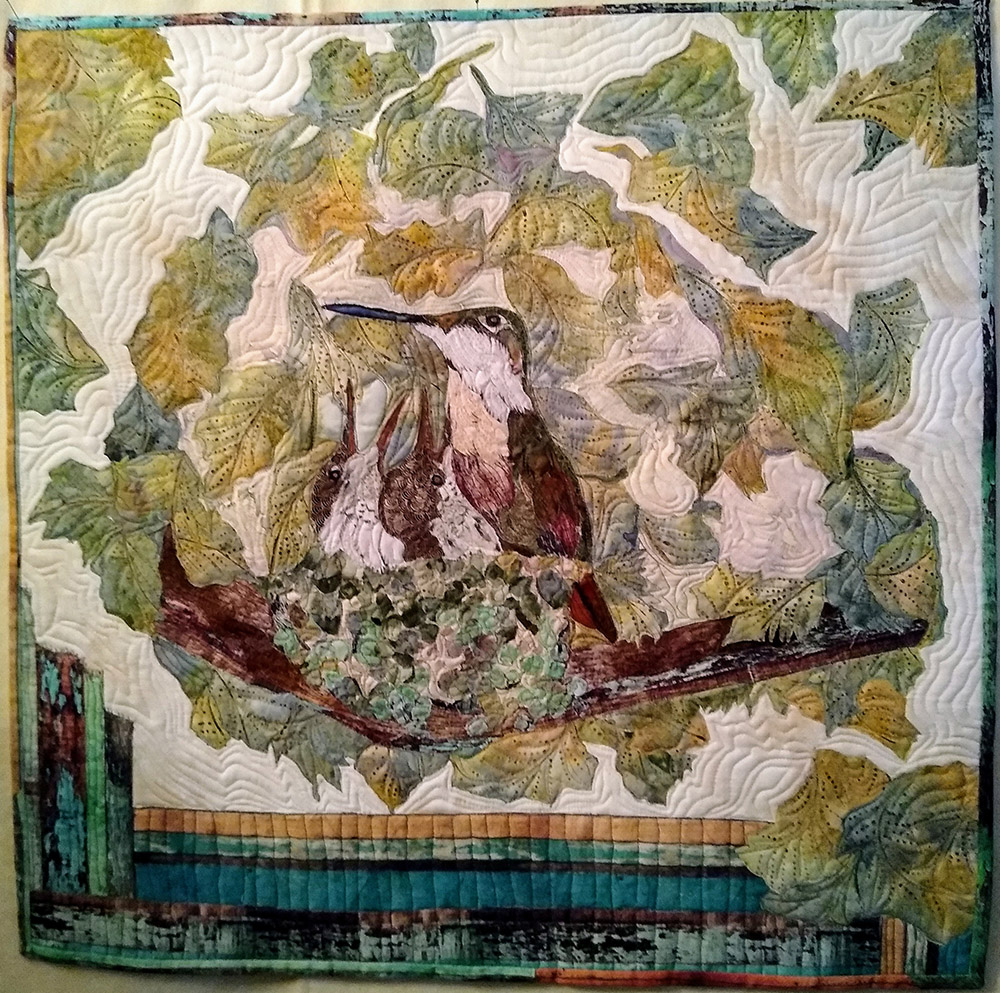
For Cathy Laws from Tucson, Arizona, this collage quilt is her latest after making the quilts in my book Serendipity Quilts, and then a couple of pet portraits. All that experience paid off in the finished quilt above. At first glance, there’s a swirl of movement surrounding the trio, yet there’s a serenity to the colors and to the mama hummer, like she’s taking a moment of stillness and meditation before dealing with her demanding babes. As I looked closer, I saw how nicely Cathy used the prints in her fabrics to represent the feathered textures of the birds—that’s what it’s all about. And good job for the extra step getting photo use permission.
From Cathy:
This quilt of a mother hummingbird on a nest with her chicks was inspired by a photo from a Birds and Bloom magazine. I contacted the photographer and obtained permission to use the image. I read Susan’s blog post about copyright permissions and followed through to get permission to use the image. The photo has a quote from Barbara Kingsolver on it that really connected with me. “Sometimes the strength of motherhood is greater than natural laws.” These tiny birds are very admirable as I believe mothers have to be.
Sandra Sullivan
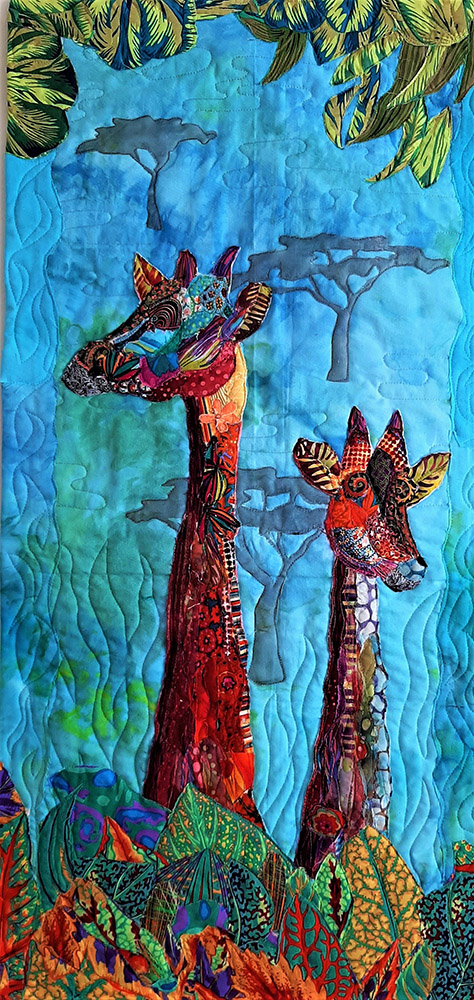
As soon as I saw the title of this quilt I knew the artist was from Australia—”cheeky” is a brilliant adjective, not uncommon to hear Down Under. And I was correct, Sandra Sullivan is from Bargara, Queensland, Australia and sent us not just one, but two colorful animal collage quilts. And these creatures aren’t just full of color, they’re full of luscious and bold pattern from the fabric prints in her stash. Sandra has “Serendipity Quilts” and is a follower of the blog. Good on ya, Sandra! Cheers!
From Sandra:
Enjoyed and developed the process over time. I have done a number of collage pieces following the technique, developing my own skills and style as I go.
Quirky “Cheeky Giraffes,” very colourful in their natural setting, the background highlights with the cut and glue binding, added such a lot to the finished piece.
Poppy Cock (below) came about after a friend suggested a rooster. Looking at fabrics I had in my stash, yes – a light bulb moment of using colour and movement for this subject. The project started to grow and develop its own character. Lots of fun. The background was a challenge, after much procrastination it came together. Auditioning a ‘pecker’ was also a challenge. I used the fussy cut and glue binding method in same fabrics to finish.
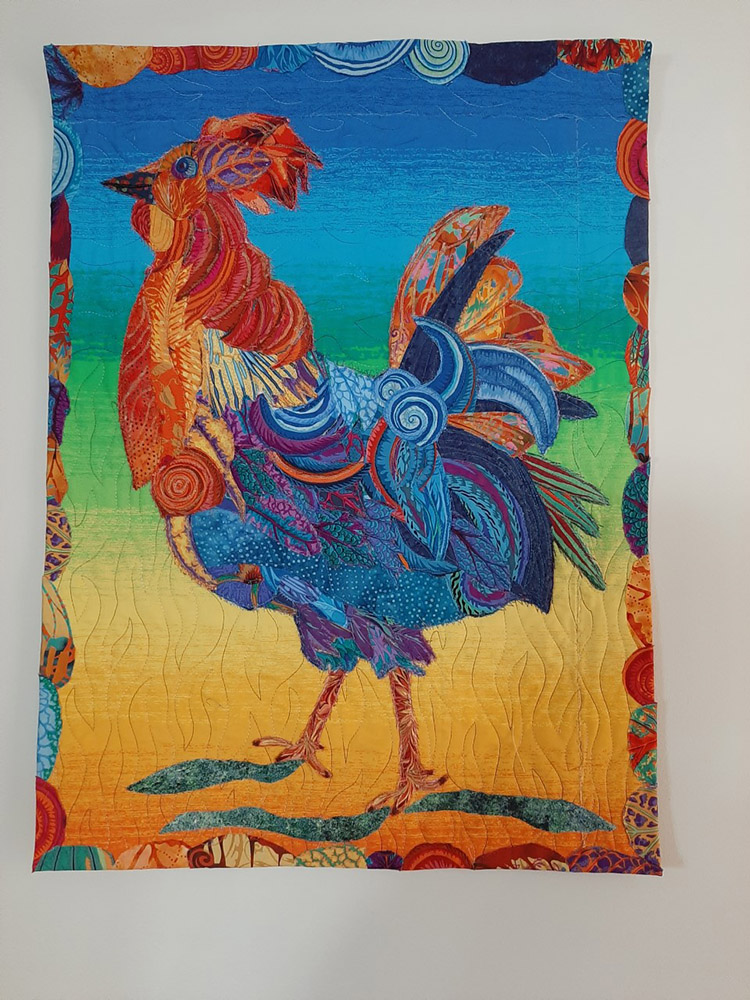
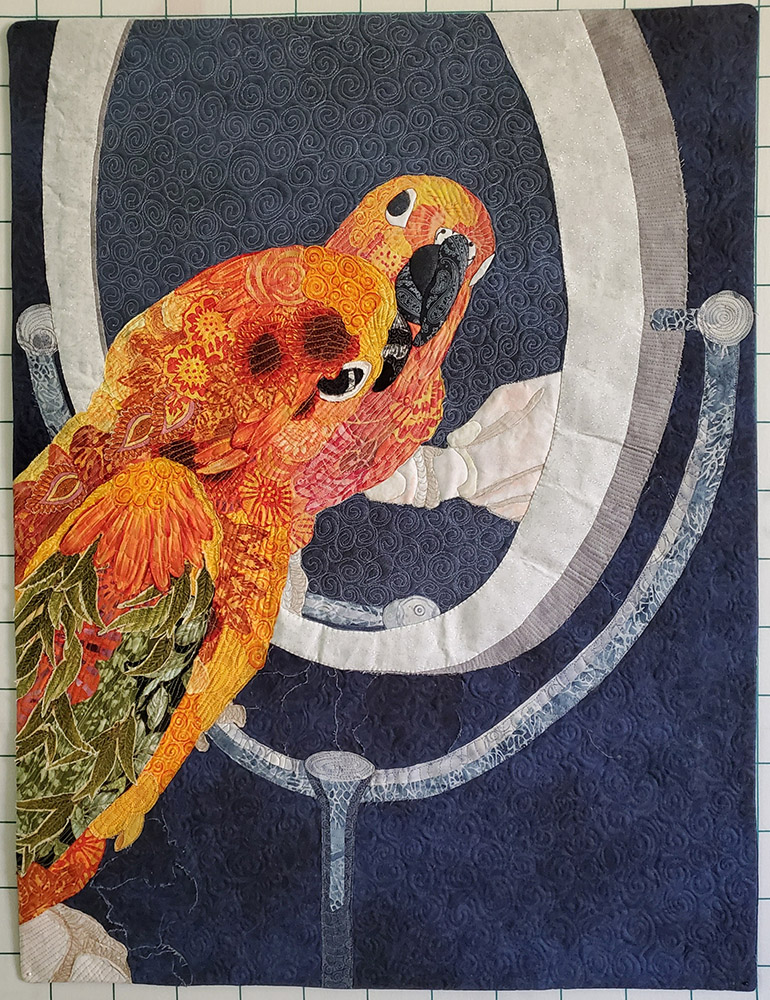
Barbara Polston from Phoenix, Arizona, first took a class with me in 2019 in Tucson, where she made a quilt of her boxers who appeared in a previous finish line—just one month after the class ended! Barbara may claim to go “realistic” in her fabric selection, but I don’t think I’ve ever seen a sun conure quite like “Mango.” Just like in collaging her pups, Brian and Vinnie, Barbara has a great eye for the printed pattern in her fabrics, and using those designs to give extra contour and form to her well-loved creatures. I appreciate Barbara’s attitude that she’s learning more about fabric collage with every piece—carry on, Barbara!
From Barbara:
I find this process stretches my creativity, and the best to depict subjects realistically. I’m not a purple cow kind of gal! Mango is my daughter’s sun conure. This quilt was made from her photo of Mango perched on her finger admiring himself in her makeup mirror. This was another learning piece. If I had to do it over, there would be construction changes. My daughter loves it, so that’s all that matters!
Lynn Koelsch
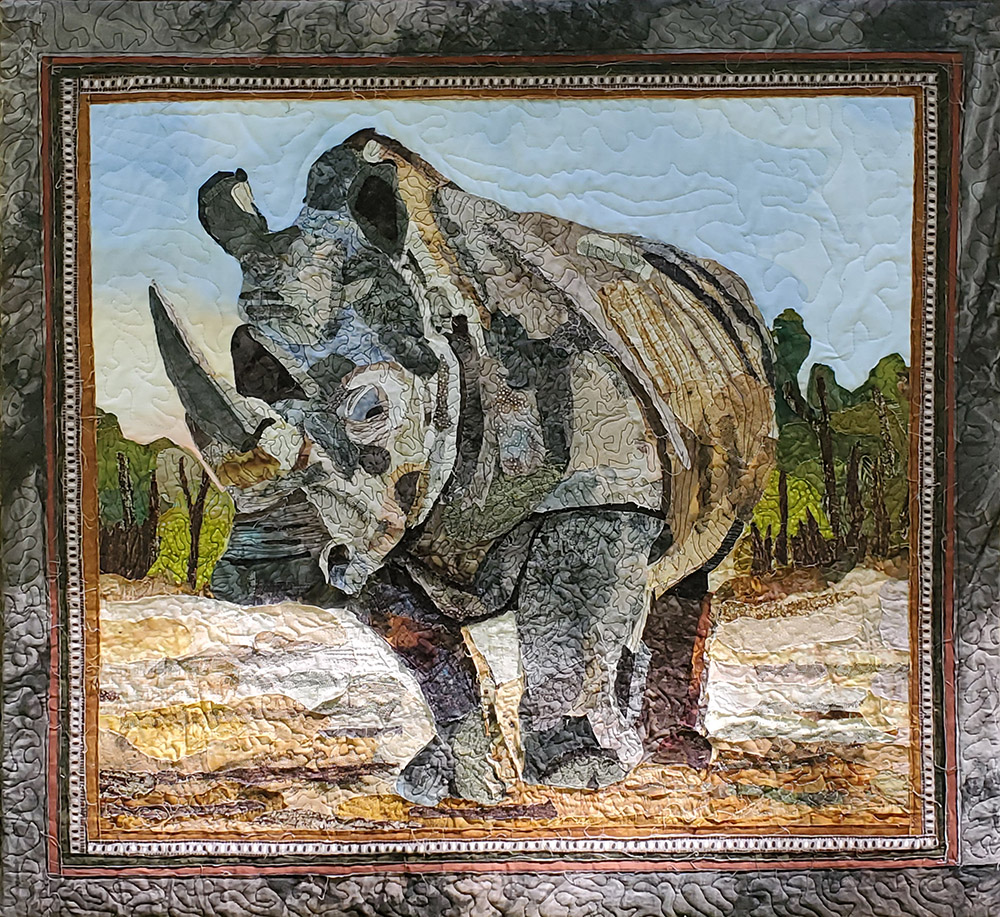
Lynn Koelsch of Raleigh, North Carolina sent in this quilt based on a photograph by National Geographic photographer Joel Sartore. I’m happy she found the Fabric Collage Master Class so useful for learning this technique, she’s done such a beautiful job with this guy (or gal)—plus I have a soft spot in my heart for rhinos. This is a being with a hefty dose of visual weight and presence—and a very successful use of your hand-painted fabrics, Lynn! Looking forward to seeing your next animal collage.
From Lynn:
I have taken Susan’s Online Master Class and would strongly recommend it. It is worth the price for those who wonder. My first animal quilt was a gorilla. Although I struggled with that, I thought I would stick with the theme of endangered animals. The Rhino was difficult for many reasons. Finding appropriate fabric that looked tough like a rhino hide and then the final stage of quilting it almost did me in. I am not an experienced quilter, so trying to get a sewing machine needle through several layers of fabric and glue caused a great deal of angst. I think I broke 4 needles, had a hard time with tension and almost gave up the whole thing.
The part I like most is the fabric on the outside border which I painted myself. I had to use hand painted fabric a lot in this quilt. This is a departure from Susan’s technique which I love. But I am a very literal person. I’m already planning my next animal. But give me a few months!
This isn’t the first time Joel Sartore, who’s photo Lynn used for this quilt, has given his permission to students of mine for use of his amazing photographs—mostly of endangered animals. In writing another Finish Line blog post, I called him about spreading the word of such a visual resource for fabric collage quilters looking for suitable subjects. I received a courteous and enthusiastic reply from Sartore’s assistant. “If that means letting more folks know about the amazing species that need our help, by all means, please include the link to our website,” she wrote. If interested in use of a photo, please contact them through the “contact us” link at the top of his website.
It should be noted that Sartore’s permission is granted solely for personal use. There is a licensing fee (which supports the Photo Ark project) of $125 or 10 percent of the sale price (whichever is greater) for use if the quilt is to be sold or entered into a competition for a prize.
Lina Rao
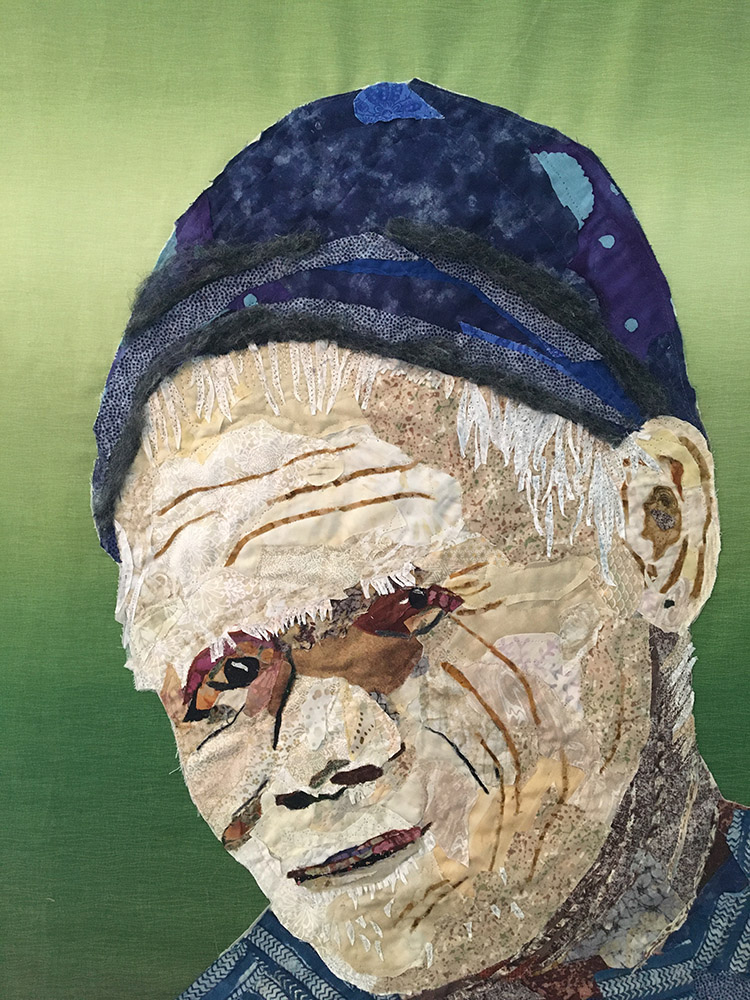
Lina Rao from San Diego was inspired by a photograph taken by a friend to create this portrait. I enjoyed reading the excitement she feels when creating fabric collage quilts—and she’s certainly done her research and homework. It’s interesting she mentioned my Eye for an Eye post, I’m quite drawn to the eyes of this portrait. They’re not at all symmetrical but that’s what makes them so interesting. Lina has a very “painterly” approach, with bits of fabric used in place of dabs of paint. Go with your instincts, Lina, and keep collaging!
From Lina:
I made my first quilt, a traditional 3″ squares back in 1975 and have made several traditional quilts since. But ever since I joined FaceBook and discovered collage quilting, I watched every Susan Carlson video I could find, bought and poured over her book Serendipity Quilts, followed and read every blog post I could find and in between all this I made 2 small collage quilts just to get over the fear of this new type of quilting!
I always wanted to make a portrait quilt and my first one was of my grand daughter which I am not too happy with but it was a great lesson on doing the eyes – took lessons from “Eye for an Eye” post – and which was the only thing about this quilt that I liked. Just then a friend posted some pictures of his trip to Nepal and one of his pictures really caught my eye! The face had so much character and it was such a good picture as far as the lighting and details that I had to make a collage of it! I got his permission and the attached picture was the result. I love this quilt and now have the confidence to go back and do over my granddaughter’s quilt, perhaps with more realistic colored fabrics.
Sandra Zube
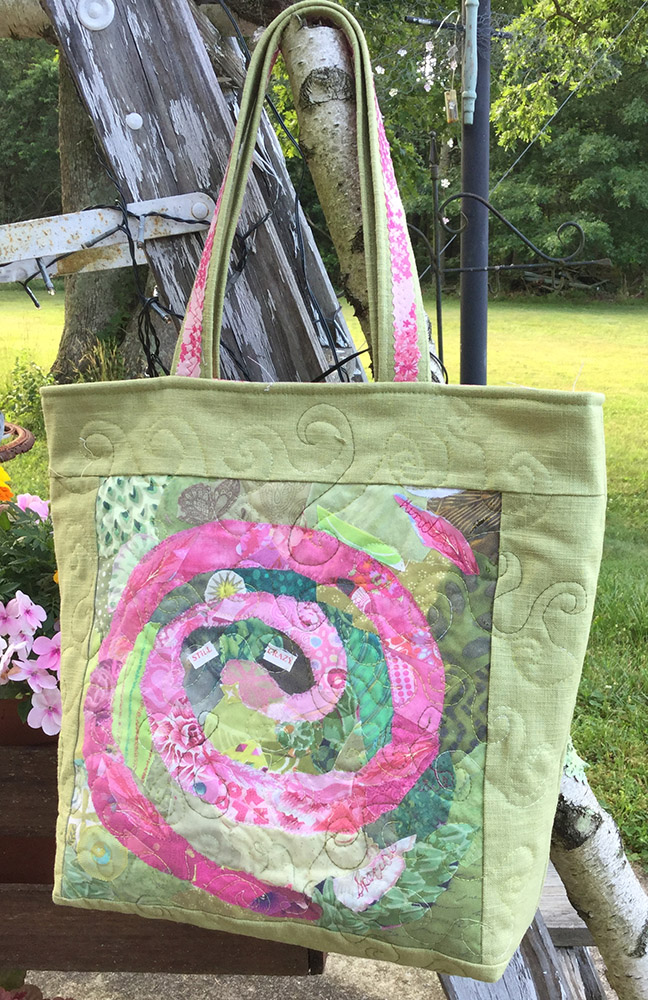
Sandra Zube from New Jersey has taken collage projects and converted them into bags. She gave this one as a gift—lovely colors and lucky recipient! Sandra, it looks like there’s a layer of tulle or other shear fabric over-top the collage? As a final layer prior to quilting, this does help to keep all the layers in place when stitched through. However, fabric collage and its water-soluble glue, is not designed to be washed—those edges are going to lift up. You may want to warn your friend that spot-washing may be best. If it does take a spin in the washer, send in a follow-up photo!
From Sandra:
Every year I make as many homemade gifts as possible. The last few years have been more creative than others. There are many very special and giving people in my life. This spiral story spoke to me. I love the process. I went on to make a moon bag and I now have a portrait I need to enlarge.
Your Support Keeps Us Going—Week In, Week Out
This blog has been and always will be free. The information contained in the blog covers all aspects of fabric collage. For those who can’t afford to purchase an eWorkshop or even my book, this blog can get them a long way toward the goal of learning the fabric collage technique.
For those can afford it, we have used Patreon for the past three and a half years as a way for readers to show us their support. Each month they make a monetary contribution, which has helped offset our cost in time to produce this free resource. Support has also made it possible for us to take the time needed to create our line of eWorkshops.
In return, we like to provide incentives to our patrons to show our appreciation. We recently updated those incentives to provide better value for their contributions while making it more efficient (and fun) for us to fulfill our obligations to them. These new rewards will go into effect at the beginning of next month, September, after payments have been processed through Patreon.
The biggest change will be the incorporation of a monthly Zoom meeting with $5 and up supporters. This meeting will be recorded so that those who can’t attend live will be able to review it at their convenience.
Here’s how the new incentives break down according to level of support:
$1/month: My heartfelt thanks.
$2/month: The above, plus a free Susan Carlson quilt “wallpaper” image for your computer or electronic device.
$5/month: The above, plus an invitation to participate as an attendee for a monthly Zoom presentation. At this level participants will be able to ask questions via text.
$10/month: The above, plus a coupon for a free recording of a Thursday Night in My Studio Live! presentation of your choice.
$20/month: The above, plus an invitation to participate as a “panelist” for the monthly Zoom presentation, being able log-in to the Zoom meeting by voice, video, and sharing, with the ability to post photos and ask questions on an in-progress piece—PLUS a $20 discount on a Fabric Collage Coaching session (regular price $100).
Patreon Fabric Collage Master Class Scholarship Challenge
Each month we provide two scholarships or the equivalent value split between three or more people, for the Fabric Collage Online Master Class Manual. We have always provided one scholarship ourselves, then due to the ongoing support of our Patreon contributors we added another.
Now we would like to make a challenge to our followers.
As of today we have 117 monthly Patreon supporters. When we reach our goal of 150 supporters—at any level—we will add another monthly scholarship for the Master Class Manual.
In this way, you can help spread the knowledge and experience of fabric collage to everyone who wants to learn.
PLEASE NOTE: As a Patreon supporter, your credit card will be charged at the beginning of every month, regardless of when you sign up during the month prior. Once we have received notice of payments, usually around the 5th of every month, we will send a notice of that month’s rewards.
In other words, if you’d like to take advantage of any Patreon awards in September, please sign up before the end of August, this coming Monday. Thank you.
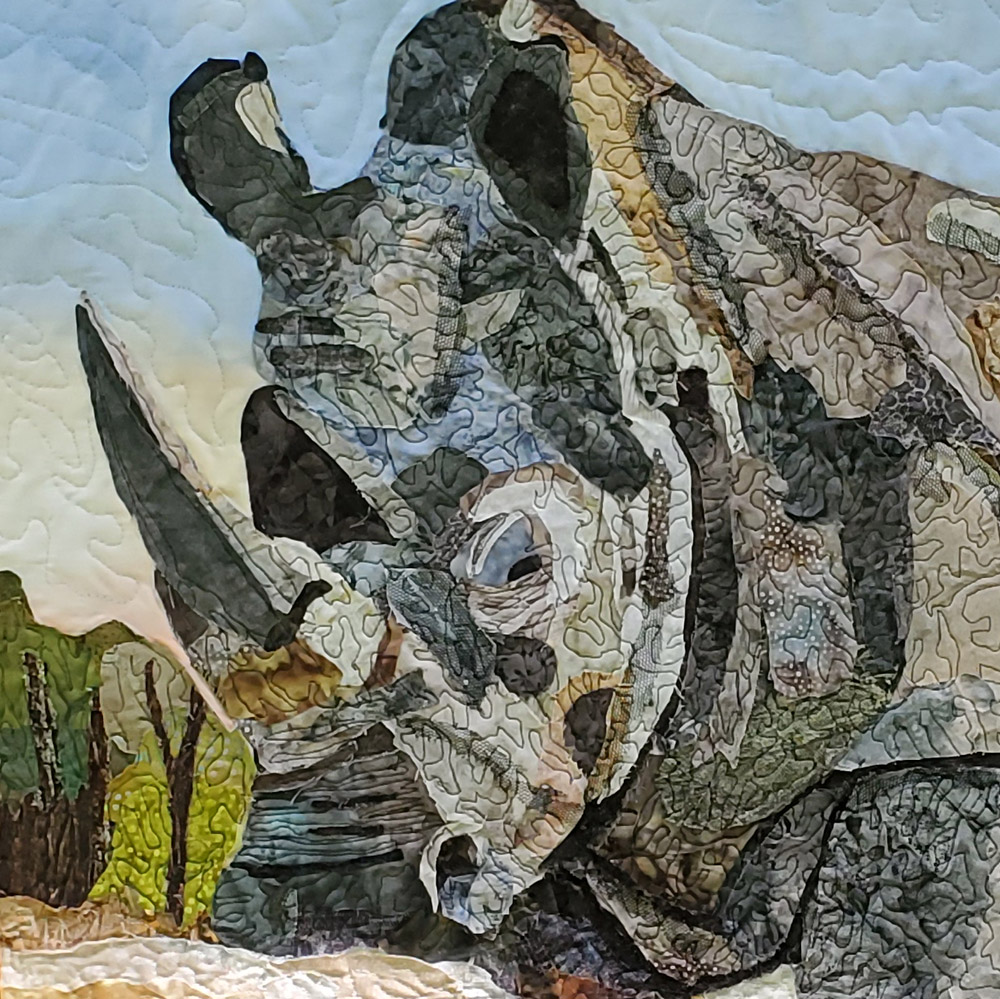
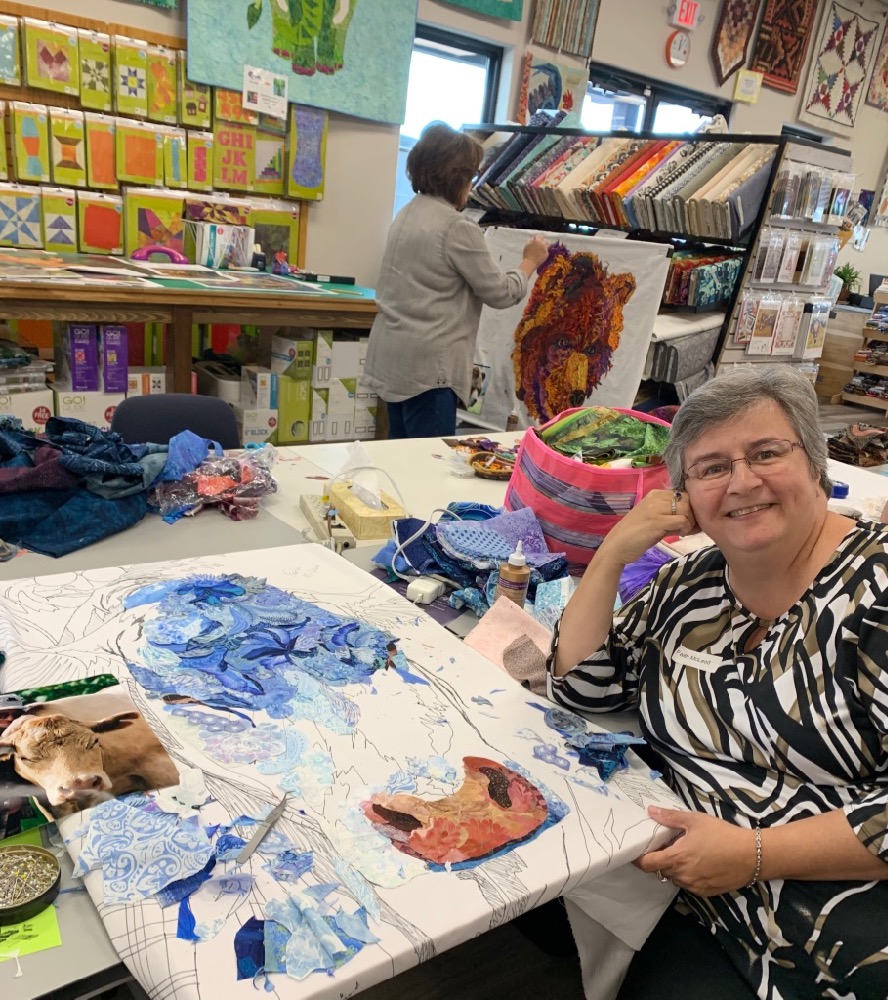




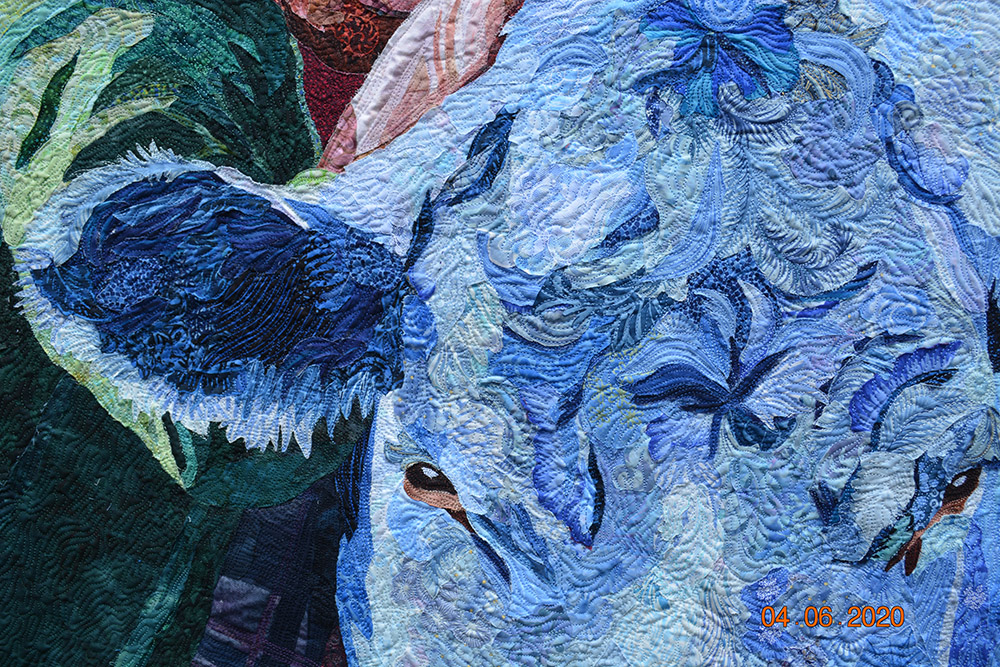






I am so happy to see “Best Friends” by Faith McLeod completed. I was in the class with Faith in Kalispell and when I saw the completed piece, I started crying just as I did when she told us the story in class. Well done Faith! Bessie and Annie are beautiful!!!
I love seeing everyone’s work. I recognize fabrics that I own, too, but haven’t used nearly as successfully!
Thank you for including one of my quilts in your blog. It is so reassuring to me to hAve your encouragement. I learn so much from your blog and other quilters, so thanks again for providing use of this blog to everyone.
So excited to see my quilt on your blog! I have learnt so much from your videos and book and now from your Thursday Night Live sessions!. Nothing like actually watching your demo! Someday I hope to take a class from you!